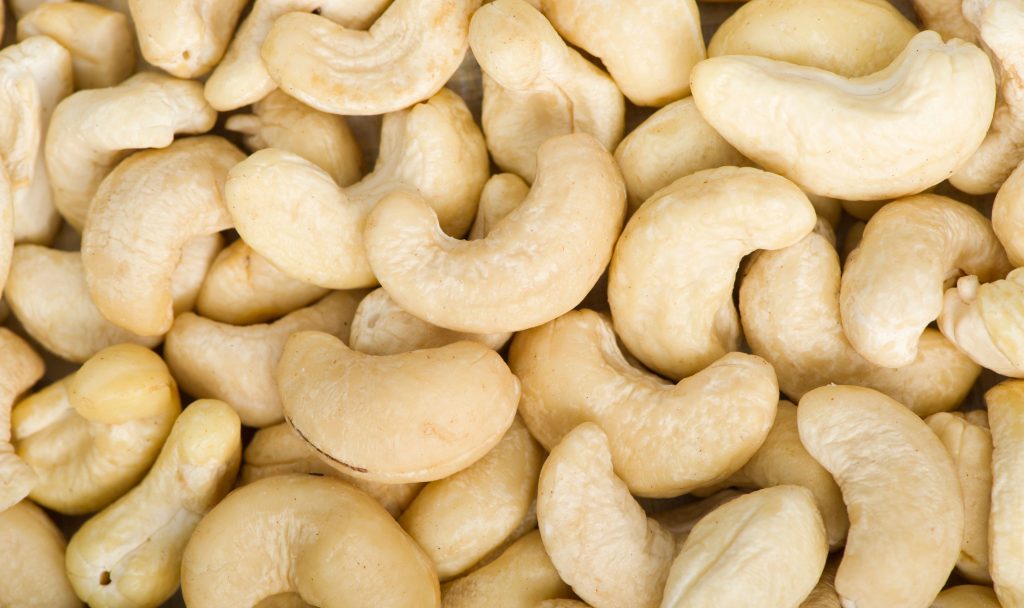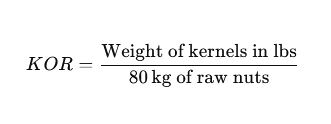Blog
Nut Count vs. KOR in Cashew Trade: Why International Buyers Must Know the Difference

The global cashew industry relies on quality, consistency, and trust. For exporters, processors, and international buyers, two key quality indicators for raw cashew nuts are Nut Count and KOR (Kernel Outturn Ratio). Though both are widely used, they are distinct. Understanding their difference—and its impact on value—is essential for informed purchasing.
1. What is Nut Count?
Let’s begin by looking at Nut Count.
Nut count refers to the number of raw cashew nuts per kilogram. It is primarily a measure of nut size.
- A low nut count (e.g., 150–170 nuts/kg) means the nuts are larger.
- A high nut count (e.g., 200–240 nuts/kg) indicates smaller nuts.
Larger nuts are generally preferred because they are easier to process and often yield higher-grade kernels, which command better prices on the international market.
2. What is KOR?
Now, let’s examine KOR and its relevance.
KOR, or Kernel Outturn Ratio, measures the yield of edible white kernels obtained from 80 kg of raw cashew nuts.
- Formula:

- For example:
- KOR 42–44 → Low quality
- KOR 45–47 → Average
- KOR 48–52 → Premium
KOR determines how much actual product the buyer will obtain after shelling and processing. A higher KOR translates directly into better returns and higher profitability.
3. The Key Difference
- Nut Count = size of the nuts.
- KOR = kernel recovery (yield) from those nuts.
A common misconception is that big nuts (low nut count) always mean a high KOR. In reality, a nut can look large but still have a poorly developed kernel, resulting in a disappointing KOR. Conversely, smaller nuts with well-formed kernels can achieve good outturn ratios.
4. Why International Buyers Must Know the Difference
For international buyers, distinguishing Nut Count from KOR is a vital risk management strategy.
- Pricing & Negotiations: Sellers may highlight nut count alone, but buyers should insist on KOR data to evaluate true value.
- Profit Margins: A deal that looks attractive on size may turn unprofitable if kernel recovery is low.
- Quality Assurance: Understanding both measures helps buyers maintain product consistency and meet customer expectations in destination markets.
5. Best Practice for Buyers
When sourcing raw cashew nuts internationally:
- Request both Nut Count and KOR values in supplier offers.
- Ask for independent quality inspection reports (e.g., from SGS or Cotecna).
- Balance preferences: Ideally, a Nut Count of 170–190 with a KOR of 48+ ensures both good size and high yield.
- Build relationships with trusted suppliers who consistently provide transparent data.
Conclusion
Nut Count shows size; KOR reveals value. Buyers who demand both stay competitive, avoid surprises, and maximize returns in the global cashew market.
At AIMEX, we specialize in sourcing, negotiating, trading, and exporting premium African food and agricultural commodities such as soybeans, cashew nuts, and fresh fruits, to buyers worldwide.
GET IN TOUCH
BANK
BTW-Identificatienummer: NL855870795B02
Kvk- nummer: 64820831
Banknummer: IBAN
NL90INGB0004111200
BIC/SWIFT: INGBNL2A

